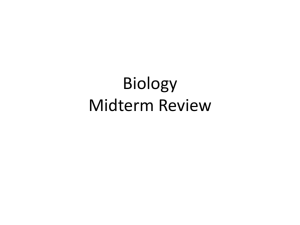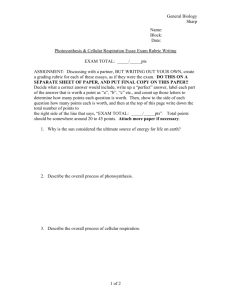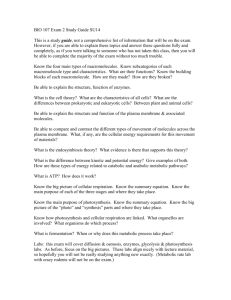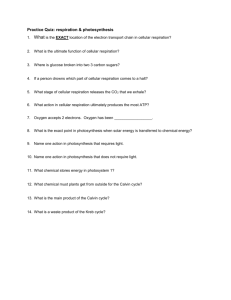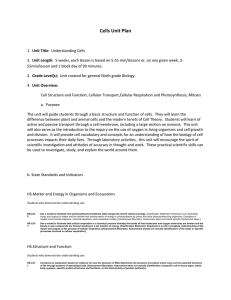Chapter 1 The Science of Biology
advertisement
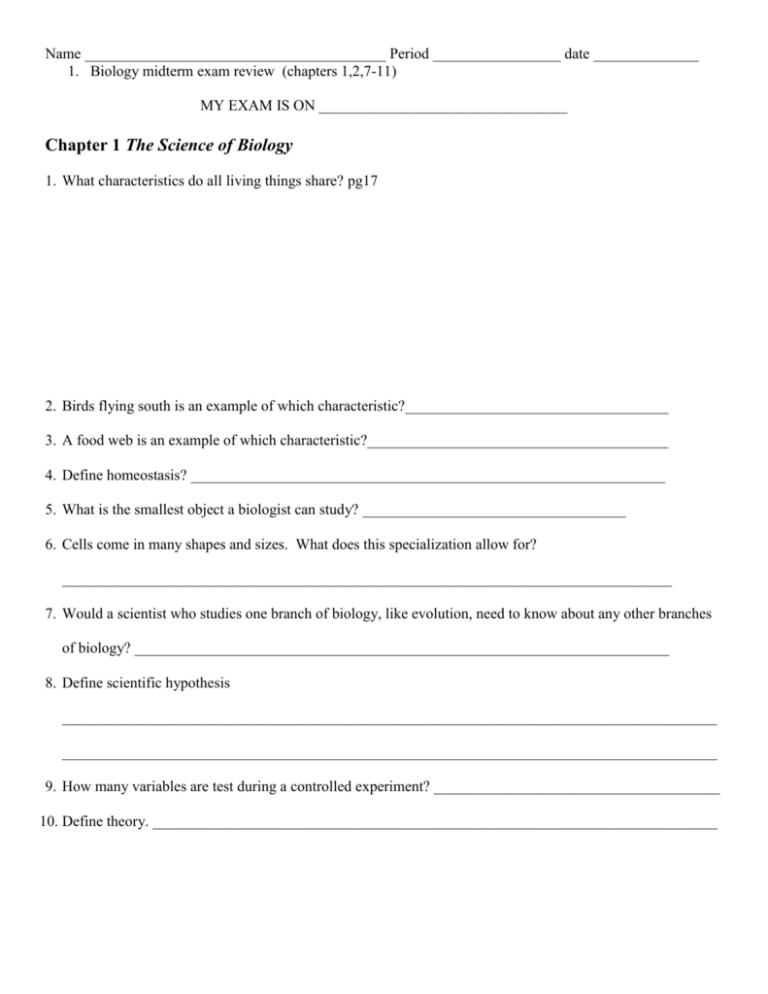
Name ________________________________________ Period _________________ date ______________ 1. Biology midterm exam review (chapters 1,2,7-11) MY EXAM IS ON _________________________________ Chapter 1 The Science of Biology 1. What characteristics do all living things share? pg17 2. Birds flying south is an example of which characteristic?___________________________________ 3. A food web is an example of which characteristic?________________________________________ 4. Define homeostasis? _______________________________________________________________ 5. What is the smallest object a biologist can study? ___________________________________ 6. Cells come in many shapes and sizes. What does this specialization allow for? _________________________________________________________________________________ 7. Would a scientist who studies one branch of biology, like evolution, need to know about any other branches of biology? _______________________________________________________________________ 8. Define scientific hypothesis _______________________________________________________________________________________ _______________________________________________________________________________________ 9. How many variables are test during a controlled experiment? ______________________________________ 10. Define theory. ___________________________________________________________________________ Chapter 2 The Chemistry of Life 1. Name the three parts of an atom. ____________________________________________________________ 2. Atomic number = _____________________________________ 3. Atomic mass = _______________________________________ 4. When chemicals react with each other, atoms are not created or destroyed, they are ____________________ 5. Give the monomer for the polymer (macromolecule) a. Carbohydrates - _________________________________ b. protein-_______________________________________ c. DNA-__________________________________ 6. What two molecules are lipids made of? ___________________________________________ 7. What is the function of DNA ______________________________________________________________ 8. What is the function of proteins _______________________________________________________________________________________ _______________________________________________________________________________________ 9. Draw a graph for a reaction that absorbs energy. 10. What is a catalyst? ________________________________________________________________________ 11. Are all catalysts enzymes? ______________________________ 12. Is a catalyst “used up” during a chemical reaction? ______________________________________________ 13. What is an enzyme? _______________________________________________________________________ 14. Enzymes work best at a specific _______________________ and _________________________. 15. How do enzymes speed up a chemical reaction? _______________________________________________________________________________________ 16. What determines an enzymes function? _______________________________________________________ 17. What is meant by the “lock and key” model? _______________________________________________________________________________________ _______________________________________________________________________________________ Chapter 7 Cell Structure and Function 1. List the levels of organization in a multicellular organism from simplest to most complex. _______________________________________________________________________________________ _______________________________________________________________________________________ 2. What invention made the discovery of cells possible? ______________________________ 3. ________________________________ cells lack a nucleus while ______________________________ cells enclose their DNA in a nucleus. 4. What is the relationship between the nucleus and the cytoplasm? _______________________________________________________________________________________ 5. What is the function of the cell membrane? ____________________________________________________ 6. What is the function of the Golgi body? _______________________________________________________ 7. What is the function of the Endoplasmic reticulum? _____________________________________________ 8. What is the function of the mitochondria? _____________________________________________________ 9. What organelle is found in plants but not animals? ______________________________________________ 10. Which two organelles are involved in energy conversion? _________________________________________ 11. Describe what happens during diffusion as equilibrium is reached _______________________________________________________________________________________ _______________________________________________________________________________________ 12. What is osmosis? ________________________________________________________________________ a. Why does an animal cell burst if placed in fresh water? _________________________________________________________________________ Chapter 8 Photosynthesis 1. Draw and label an ATP molecule. 2. What is the difference between ATP and ADP? ___________________________________ 3. Define autotroph ________________________________________________________________________ 4. Define heterotroph _______________________________________________________________________ 5. Write the overall equation for photosynthesis? _______________________________________________________________________________________ 6. What gas is given off? __________________________________ 7. The energy needed to power photosynthesis comes from ___________________________________. 8. Is oxygen required for a candle to burn? _________________________________ 9. What would happen to sugar production if carbon dioxide is completely removed from a plants environment? __________________________________________________ 10. Draw a graph that represents the effect of temperature on the rate of photosynthesis. Chapter 9 Cellular Respiration 1. Write the equation for cellular respiration ___________________________________________________________________________________ 2. Cellular respiration occurs in ___________________________________________. 3. Cellular respiration releases the energy in _________________________________. 4. Cellular respiration is call aerobic because it requires _________________________________. 5. How do animals get the energy they need? ____________________________________________________________________________________ 6. In what way are photosynthesis and cellular respiration opposite? ____________________________________________________________________________________ 7. Glycolysis starts with what molecule? _____________________________ 8. If oxygen is available, glycolysis is followed by _____________________________________________ 9. How many molecules of ATP are produced for each glucose molecule? ____________________________ 10. Where does lactic acid fermentation occur? ___________________________________ Chapter 10 Cell growth, Division and Reproduction 1. Cells need to be small so they can _________________________________________________________ 2. DNA is replicated during _______________________________________ of the cell cycle. 3. Draw and label a typical chromosome (in its replicated state) 4. What is the difference between cell division and mitosis? _______________________________________________________________________________________ 5. List the phases of mitosis in order. _________________________________________________________ 6. During which phase of mitosis do the chromosomes line up in the middle? __________________________ 7. When are the chromosomes visible? _______________________________________________________ 8. Cancer is disorder in which cell have lost the ability to control their ______________________________. 9. What are stem cells? ____________________________________________________________________ Chapter 11 Introduction to Genetics 1. Mendel’s principles apply to __________________________________________________ 2. Define alleles _______________________________________________________________________ 3. A heterozygous tall plant is crossed with a short plant. What is the probability that an F1 plant will be tall? ______________________________ 4. Define homozygous ____________________________________________________________________ 5. Define heterozygous ____________________________________________________________________ 6. Tt x TT What are the phenotypes of the offspring? ______________________________________ 7. If a plant is tt what is true of it parents? 8. If an organism’s diploid number is 10, what is its haploid number? _________________________ 9. Gametes are produced by the process of ________________________________ 10. Mitosis produces __________________________ cells while meiosis produces ___________________ 11. Define crossing-over ___________________________________________________________________ 12. How is meiosis I different from mitosis? ____________________________________________________________________________________


